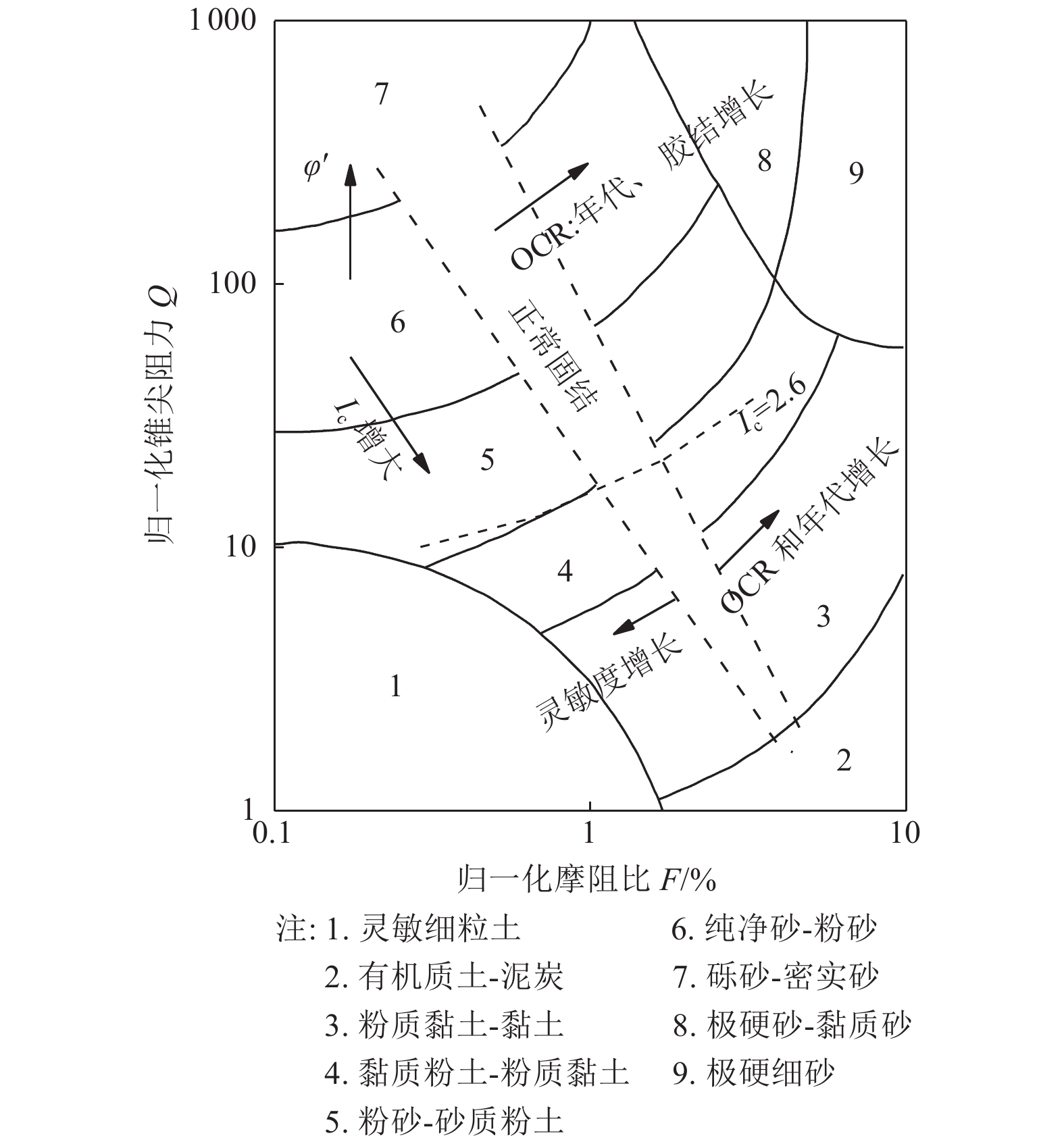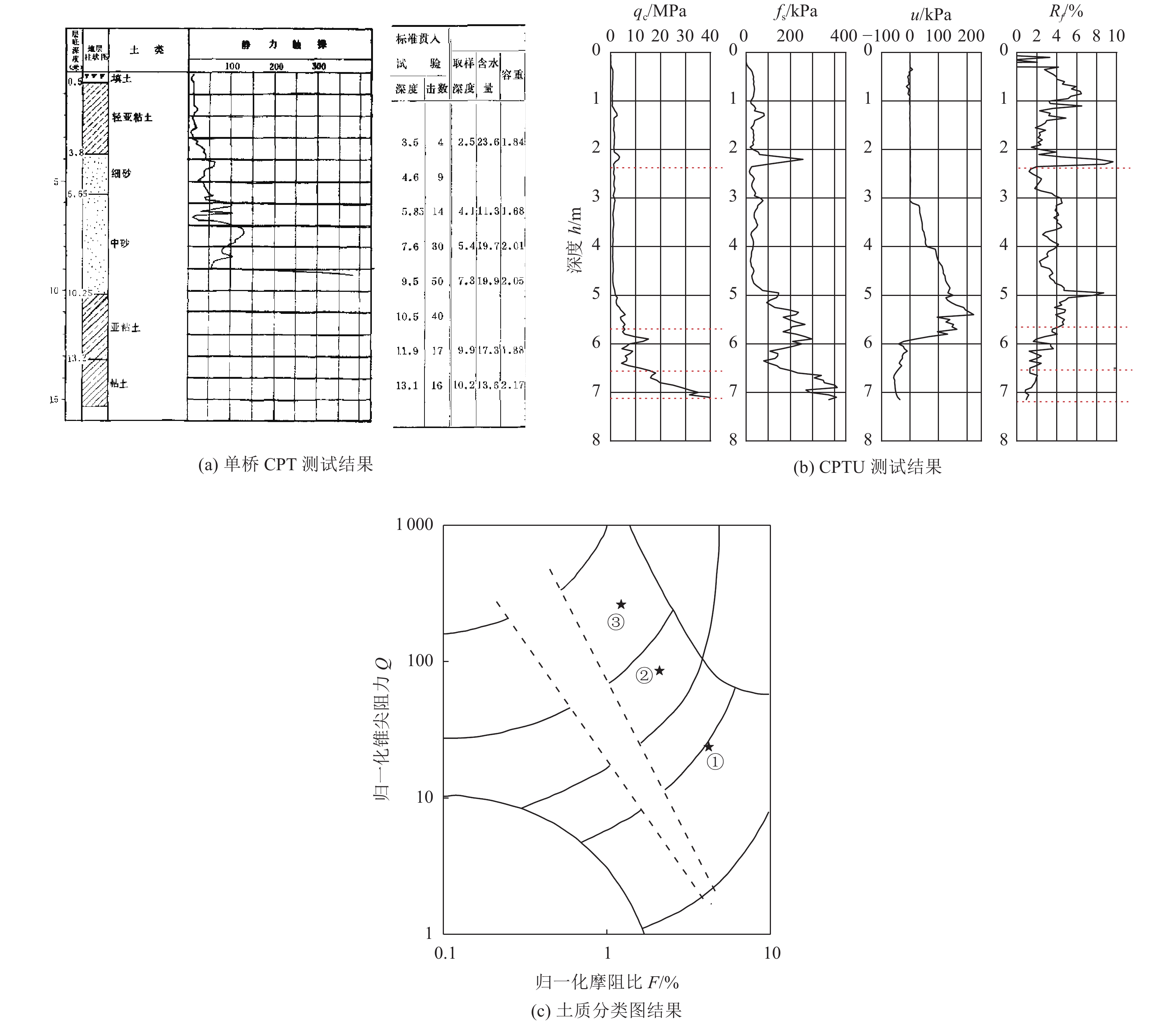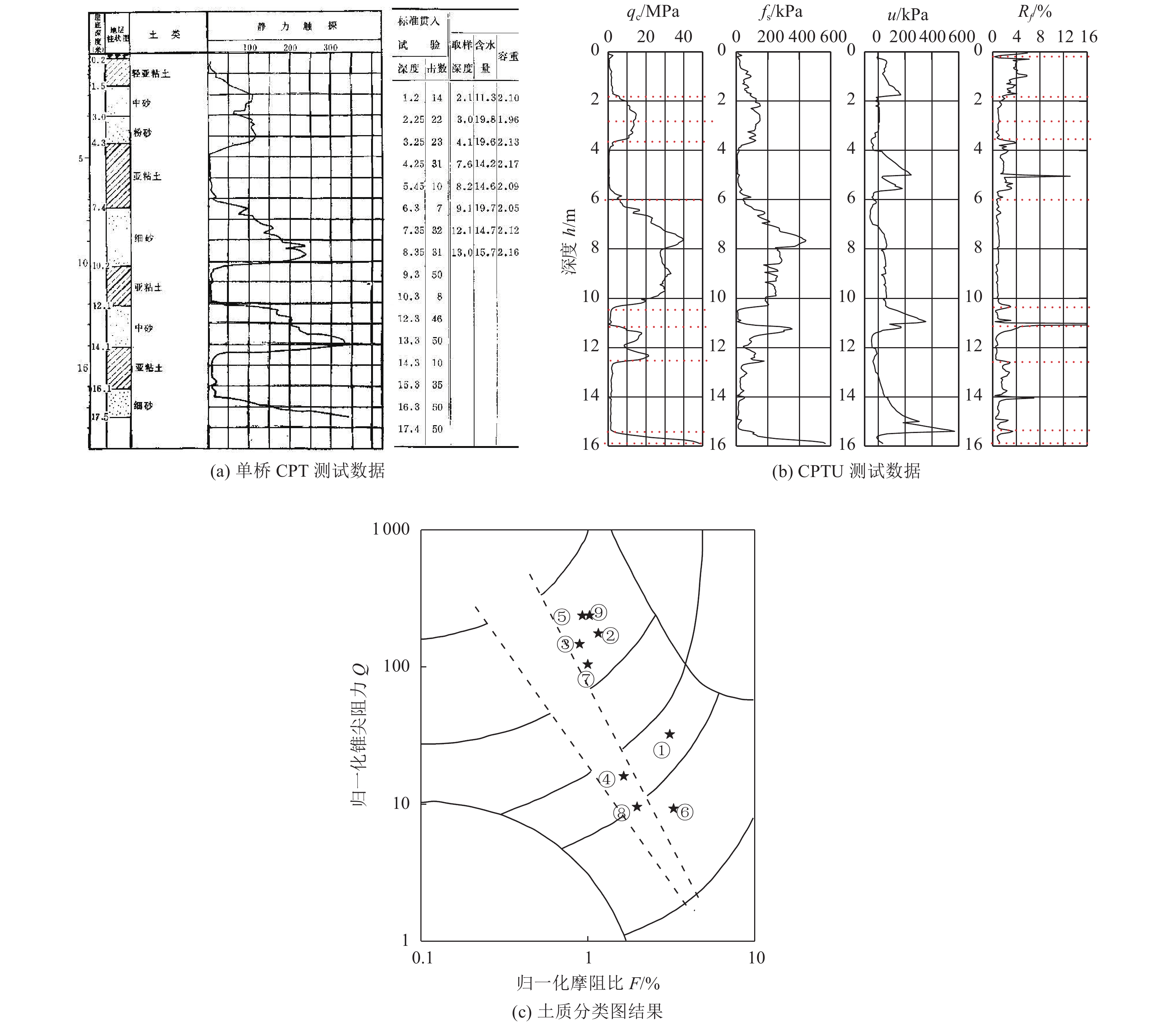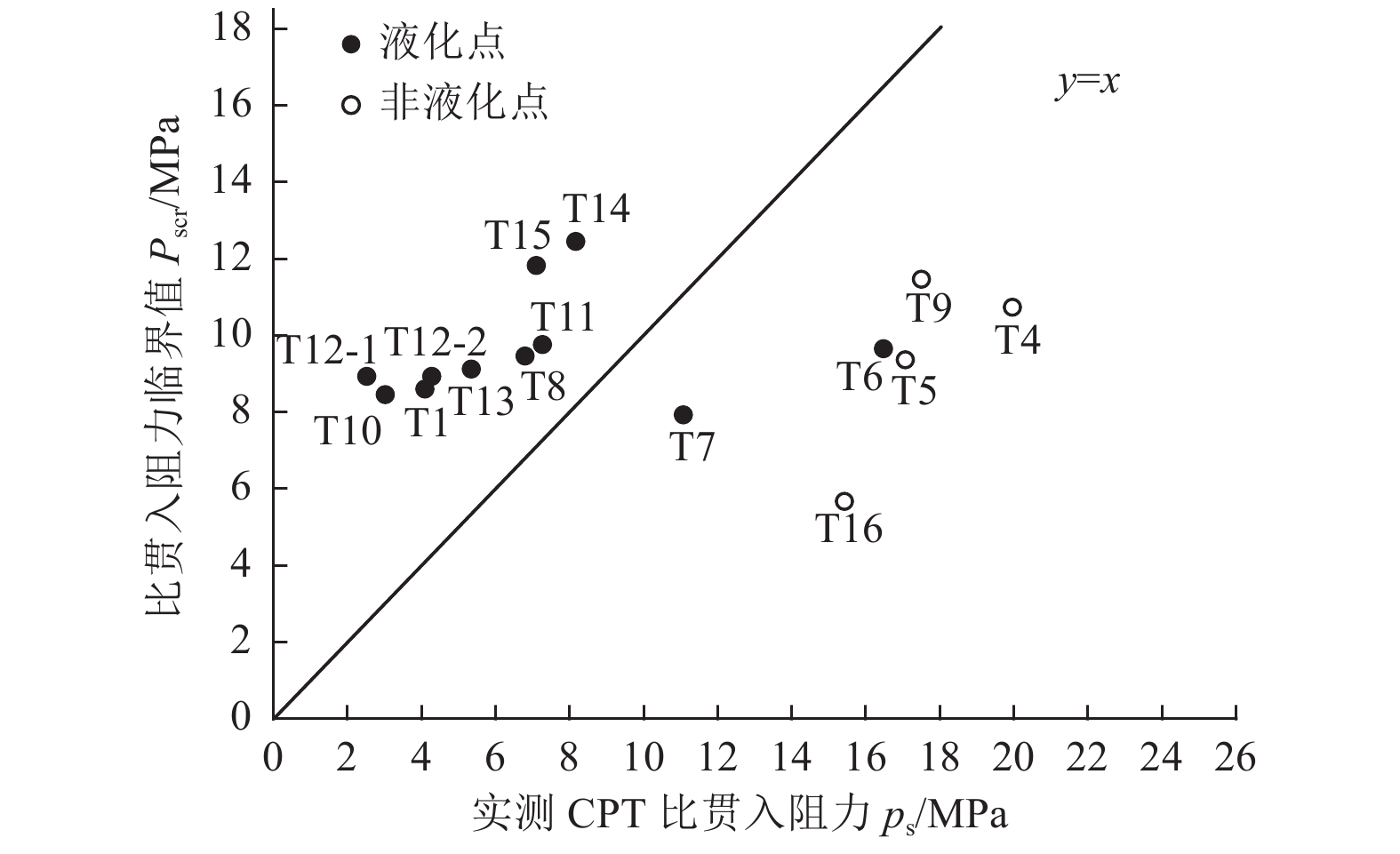Inspection on CPT-based Liquefaction Database from 1976 Tangshan Earthquake
-
摘要: 1976年唐山大地震引发了范围广、灾害重的液化震害。铁道部科学研究院等单位于1977、1978年对液化场地进行了单桥静力触探测试。但单桥静力触探在数据指标方面存在缺陷,与国际标准不接轨。中国地震局工程力学研究所与东南大学等单位于2007年对上述唐山地区部分测点再次进行了孔压静力触探(CPTU)测试。本文通过对比2次静力触探数据,利用Robertson土质分类图,进行新孔压静力触探数据土类分层检验,将土类检验结果与单桥静力触探测试时钻孔柱状图进行对比,发现大部分测点土层土类均能较好对应,现场测试力学指标沿深度变化趋势较相符,仅剔除了错误点T2、T3。对所有测点选定液化层,分别建立基于单桥静力触探测试比贯入阻力ps和基于孔压静力触探测试锥尖阻力qc的液化数据库。利用基于静力触探测试(CPT)的我国规范液化判别方法检验了2个数据库,发现对单桥静力触探测试的数据库液化判别效果好,而对孔压静力触探测试的数据库液化判别效果较差,说明经过30年的时间,土层液化可能已发生较大改变。因此,基于孔压静力触探测试的液化数据库可靠性较低,基于该数据库对液化判别方法进行改进意义较小。Abstract: The 1976 Tangshan earthquake resulted in widespread liquefaction. China academy of railway sciences and other institutes conducted single bridge probe CPT test on these liquefied and non-liquefied sites in 1977—1978. However, the single bridge CPT measured only specific penetration resistance, and is not conformity with international standards. Institute of Engineering Mechanics, CEA and Southeast University retested 18 sites using piezocone penetration test (CPTU) in 2007. By comparing two CPT profiles, and comparing soil types obtained from Robertson CPT-based soil behavior-type chart with borings in first test, it is found that soil layers fit reasonably well for most of sites, and in-situ indicators also change same trend along depth for most of sites, finally only two error sites(T2, T3) were excluded. Critical layers were selected for all sites, a database of ps-based liquefaction case histories and another database of qc-based liquefaction case histories were constructed. Two databases were tested by CPT-based Chinese code methods, liquefaction discrimination result for the first database is good, while liquefaction discrimination result for the second database is poor, which shows that potential of soil liquefaction had changed significantly after 30 years. Therefore, the liquefaction database based on CPTU test has low reliability, and has little help for future improvement of liquefaction discrimination methods.
-
Key words:
- Tangshan earthquake /
- Liquefaction /
- Cone penetration test /
- Database /
- Inspection
-
表 1 T1测点CPTU分层结果
Table 1. CPTU soil layer classification result of site T1
分层深度/m qc/MPa fs/kPa Rf /% σv /kPa σ'v/kPa n Q F/% Ic 2.40~5.70 1.72 69.16 3.73 73.03 69.60 1.0 23.71 4.19 2.79 5.70~6.55 8.23 175.64 2.36 109.78 86.01 0.5 87.56 2.16 2.18 6.55~7.15 26.67 341.91 1.40 122.69 91.82 0.5 277.04 1.29 1.68 表 2 T1测点土层土类检验结果
Table 2. Soil layer inspection results of site T1
序号 单桥CPT测试钻孔土类 Robertson土质分类图土类 ① 轻亚黏土(深度0.50~3.80 m) 粉质黏土-黏土(深度2.40~5.70 m) ② 细砂(深度3.80~5.65 m) 粉砂-砂质粉土(深度5.70~6.55 m) ③ 中砂(深度5.65~10.20 m) 纯净砂-粉砂(深度6.55~7.15 m) 表 3 T2测点CPTU分层结果
Table 3. CPTU soil layer classification result of site T2
分层深度/m qc/MPa fs/kPa Rf /% σv/kPa σ'v/kPa n Q F/% Ic 0.35~2.20 1.09 72.25 6.57 24.62 24.37 1.0 43.65 6.79 2.75 2.20~4.20 2.97 245.18 8.36 61.78 42.67 1.0 68.10 8.44 2.70 4.20~6.90 3.99 232.30 5.86 107.15 65.01 1.0 59.73 5.98 2.62 6.90~8.30 6.52 257.71 3.75 146.73 84.50 0.5 69.30 4.05 2.45 8.30~8.45 18.63 302.42 1.79 161.75 91.93 0.5 192.58 1.64 1.86 表 4 T2测点土层土类检验结果
Table 4. Soil layer inspection results of site T2
序号 单桥CPT测试钻孔土类 Robertson土质分类图土类 ① 亚黏土(深度0~2.3 m) 粉质黏土-黏土(深度0.35~2.20 m) ② 细砂(深度2.3~3.7 m) 极硬细砂(深度2.20~4.20 m) ③ 中砂(深度3.7~4.4 m) 粉质黏土-黏土(深度4.20~6.90 m) ④ 淤泥质亚黏土(深度4.4~5.0 m) 黏质粉土-粉质黏土(深度6.90~8.30 m) ⑤ 粉砂(深度5.0~6.8 m) 纯净砂-粉砂(深度8.30~8.45 m) 表 5 T3测点CPTU分层结果
Table 5. CPTU soil layer classification result of site T3
分层深度/m qc/MPa fs/kPa Rf /% σv/kPa σ'v/kPa n Q F/% Ic 1.05~4.40 0.44 33.49 7.94 52.61 40.60 1.0 9.64 8.56 3.29 4.40~6.20 0.77 42.84 5.42 102.32 65.08 1.0 10.32 6.38 3.18 6.20~7.30 5.87 179.92 3.11 130.48 79.03 0.5 64.56 3.13 2.39 7.30~7.95 29.33 316.81 1.28 148.01 87.98 0.5 311.11 1.09 1.59 表 6 T3测点土层土类检验结果
Table 6. Soil layer inspection results of site T3
序号 单桥CPT测试钻孔土类 Robertson土质分类图
土类① 无 粉质黏土-黏土
(深度1.05~4.40 m)② 无 粉质黏土-黏土
(深度4.40~6.20 m)③ 亚黏土
(深度0.4~1.8 m)黏质粉土-粉质黏土
(深度6.20~7.30 m)④ 粉砂
(深度1.8~3.0 m)纯净砂-粉砂
(深度7.30~7.95 m)表 7 T6测点CPTU分层结果
Table 7. CPTU soil layer classification result of site T6
分层深度/m qc/MPa fs/kPa Rf /% σv/kPa σ'v/kPa n Q F/% Ic 0.50~2.85 3.04 60.75 3.04 32.33 30.62 0.5 54.36 2.02 2.31 2.85~5.00 2.48 67.54 4.16 75.77 52.01 0.5 33.36 2.81 2.56 5.00~6.10 17.71 164.39 1.07 106.50 66.81 0.5 215.47 0.93 1.65 6.10~7.00 35.30 384.7 1.11 125.42 75.94 0.5 403.68 1.09 1.53 表 8 T6测点土层土类检验结果
Table 8. Soil layer inspection results of site T6
序号 单桥CPT测试钻孔土类 Robertson土质分类图土类 ① 亚黏土(深度0~2.25m) 粉砂-砂质粉土(深度0.50~2.85m) ② 黏土(深度2.25~4.40m) 黏质粉土-粉质黏土(深度2.85~5.00m) ③ 细砂(深度4.40~5.50m) 纯净砂-粉砂(深度5.00~6.10m) ④ 中砂(深度5.50~6.50m) 纯净砂-粉砂(深度6.10~7.00m) 表 9 T15测点CPTU分层结果
Table 9. CPTU soil layer classification result of site T15
分层深度/m qc/MPa fs/kPa Rf /% σv/kPa σ'v/kPa n Q F/% Ic 0~0.3 5.35 36.79 0.80 2.98 2.98 0.5 309.53 0.69 1.44 0.3~1.4 17.23 126.53 0.80 17.02 17.02 0.5 417.42 0.73 1.38 1.4~4.8 12.66 97.74 0.81 60.39 39.81 0.5 199.69 0.78 1.61 4.8~6.5 23.57 212.09 0.89 109.784 64.21 0.5 292.79 0.90 1.55 6.5~6.9 34.00 319.35 0.93 130.90 75.04 0.5 390.93 0.94 1.48 表 10 T15测点土层土类检验结果
Table 10. Soil layer inspection results of site T15
序号 单桥CPT测试钻孔土类 Robertson土质分类图土类 ① 细砂(深度0~1.1 m) 纯净砂-粉砂(深度0~0.3 m) ② 中砂(深度1.1~2.6 m) 纯净砂-粉砂(深度0.3~1.4 m) ③ 粉砂(深度2.6~6.2 m) 纯净砂-粉砂(深度1.4~4.8 m) ④ 细砂(深度6.2~9.3 m) 纯净砂-粉砂(深度4.8~6.5 m) ⑤ 中砂(深度9.3~10.5 m) 纯净砂-粉砂(深度6.5~6.9 m) 表 11 T16测点CPTU分层结果
Table 11. CPTU soil layer classification result of site T16
分层深度/m qc/MPa fs/kPa Rf /% σv/kPa σ'v/kPa n Q F/% Ic 0.25~1.80 1.65 55.03 3.67 18.98 18.98 0.5 37.62 3.36 2.58 1.80~2.80 11.57 132.98 1.21 42.94 42.94 0.5 175.99 1.15 1.77 2.80~3.60 11.85 113.82 1.00 60.89 60.89 0.5 151.18 0.96 1.77 3.60~6.00 1.37 22.76 2.23 91.47 78.73 1.0 16.35 1.77 2.69 6.00~10.40 25.55 234.77 0.97 160.48 114.42 0.5 237.38 0.92 1.61 10.40~11.10 1.53 43.13 4.26 213.75 142.70 1.0 9.28 3.26 3.04 11.10~12.50 14.29 138.92 1.09 235.05 153.71 0.5 113.38 0.99 1.87 12.50~15.50 1.91 35.20 1.74 277.65 174.75 1.0 9.37 2.15 2.94 15.50~15.90 33.09 334.69 0.97 309.59 190.03 0.5 237.85 1.02 1.65 表 12 T16测点土层土类检验结果
Table 12. Soil layer inspection results of site T16
序号 单桥CPT测试钻孔土类 Robertson土质分类图
土类① 轻亚黏土(0.2~1.5 m) 黏质粉土-粉质黏土(深度0.25~1.8 m) ② 中砂(1.5~3.0 m) 纯净砂-粉砂(深度1.8~2.8 m) ③ 粉砂(3.0~4.3 m) 纯净砂-粉砂(深度2.8~3.6 m) ④ 亚黏土(4.3~7.4 m) 黏质粉土-粉质黏土(深度3.6~6 m) ⑤ 细砂(7.4~10.2 m) 纯净砂-粉砂(深度6~10.4 m) ⑥ 亚黏土(10.2~12.1 m) 粉质黏土-黏土(深度10.4~11.1 m) ⑦ 中砂(12.1~14.1 m) 纯净砂-粉砂(深度11.1~12.5 m) ⑧ 亚黏土(14.1~16.1 m) 粉质黏土-黏土(深度12.5~15.5 m) ⑨ 细砂(12.1~14.1 m) 纯净砂-粉砂(深度15.5~15.9 m) 表 13 比贯入阻力和锥尖阻力基准值ps0、qc0
Table 13. Liquefied reference value of specific penetration resistance and cone tip resistance
参数 抗震设防烈度 7度 8度 9度 ps0/MPa 5.0~6.0 11.5~13.0 18.0~20.0 qc0/MPa 4.6~5.5 10.5~11.8 16.4~18.2 表 14 土性修正系数αp值
Table 14. Values of soil property correction factor αp
参数 土类 砂土 粉土 摩阻比Rf Rf≤0.4 0.4<Rf≤0.9 Rf>0.9 αp 1. 00 0.60 0.45 表 15 基于单桥CPT测试的唐山地震液化数据库
Table 15. Database of ps-based liquefaction case histories in Tangshan earthquake
测点 液化
情况地震
烈度/度土层
深度/mPs0/MPa dw/m du/m αw αu αp Pscr/MPa 实测Ps/MPa 液化判别 T1 液化 10 3.80~5.65 23.5 3.70 3.80 0.89 0.91 0.45 8.56 4.05 是 T4 非液化 10 2.90~3.50 23.5 1.10 2.90 1.06 0.96 0.45 10.69 19.92 否 T5 非液化 10 3.15~5.20 23.5 3.00 3.15 0.94 0.94 0.45 9.32 17.02 否 T6 液化 10 4.40~5.50 23.5 1.50 4.40 1.03 0.88 0.45 9.61 16.44 否 T7 液化 10 6.05~7.05 23.5 3.00 6.05 0.94 0.80 0.45 7.89 11.03 否 T8 液化 10 3.95~7.00 23.5 2.20 3.95 0.99 0.90 0.45 9.42 6.75 是 T9 非液化 10 6.70~8.20 23.5 1.10 6.70 1.06 0.77 0.60 11.42 17.46 否 T10 液化 9 3.00~5.50 19.0 1.45 3.00 1.04 0.95 0.45 8.41 2.98 是 T11 液化 9 0.85~3.40 19.0 0.85 0.85 1.07 1.06 0.45 9.71 7.22 是 T12-1 液化 9 1.80~3.20 19.0 1.55 1.80 1.03 1.01 0.45 8.89 2.48 是 T12-2 液化 9 3.20~10.20 19.0 1.55 1.80 1.03 1.01 0.45 8.89 4.24 是 T13 液化 9 2.00~3.80 19.0 1.05 2.00 1.06 1.00 0.45 9.08 5.30 是 T14 液化 9 1.25~2.10 19.0 1.25 1.25 1.05 1.04 0.60 12.40 8.13 是 T15 液化 9 2.60~6.20 19.0 1.00 2.60 1.07 0.97 0.60 11.78 7.06 是 T16 非液化 9 7.40~10.20 19.0 3.50 7.40 0.90 0.73 0.45 5.63 15.38 否 表 16 基于CPTU测试的唐山地震液化数据库
Table 16. Database of qc-based liquefaction case histories in Tangshan earthquake
测点 液化
情况地震
烈度/度土层
深度/mqc0/MPa dw/m du/m αw αu αp qccr/MPa 实测qc/MPa 液化判别 T1 液化 10 5.70~6.55 21.2 3.70 5.70 0.89 0.8150 0.45 6.92 8.23 否 T4 非液化 10 4.40~5.00 21.2 1.10 4.40 1.06 0.8800 0.45 8.89 9.49 否 T5 非液化 10 3.00~4.20 21.2 3.00 3.00 0.94 0.9500 0.45 8.47 6.94 是 T6 液化 10 5.00~6.10 21.2 1.50 5.00 1.03 0.8500 0.45 8.37 17.71 否 T7 液化 10 3.00~4.00 21.2 3.00 3.00 0.94 0.9500 0.45 8.47 4.20 是 T8 液化 10 4.75~7.40 21.2 2.20 4.75 0.99 0.8630 0.45 8.12 8.67 否 T9 非液化 10 3.30~4.80 21.2 1.10 3.30 1.06 0.9350 0.60 12.59 9.25 是 T10 液化 9 5.00~6.70 17.3 1.45 5.00 1.04 0.8500 0.45 6.85 4.93 是 T11 液化 9 1.40~2.60 17.3 0.85 1.40 1.07 1.0300 0.45 8.62 4.02 是 T12-1 液化 9 2.45~4.80 17.3 1.55 2.45 1.03 0.9775 0.45 7.83 2.57 是 T12-2 液化 9 4.80~9.40 17.3 1.55 2.45 1.03 0.9775 0.45 7.83 9.28 否 T13 液化 9 1.65~3.00 17.3 1.05 1.65 1.06 1.0175 0.45 8.41 5.42 是 T14 液化 9 1.25~2.10 17.3 1.25 1.25 1.05 1.0375 0.60 11.29 11.04 是 T15 液化 9 1.40~4.80 17.3 1.00 1.40 1.07 1.0300 0.60 11.39 12.66 否 T16 非液化 9 6.00~10.40 17.3 3.50 6.00 0.90 0.8000 0.45 5.62 25.55 否 -
[1] 董林, 王兰民, 夏坤等, 2017. 基于台湾集集地震数据的CPT与SPT液化判别方法比较. 岩土力学, 38(12): 3643—3648Dong L. , Wang L. M. , Xia K. , et al. , 2017. Comparison of CPT-based and SPT-based liquefaction discrimination methods by Taiwan Chi-Chi earthquake data[J]. Rock and Soil Mechanics, 38(12): 3643—3648. (in Chinese) [2] 董林, 严武建, 夏坤等, 2018. 饱和黄土场地原位试验及液化势评价. 震灾防御技术, 13(4): 950—958 doi: 10.11899/zzfy20180422Dong L. , Yan W. J. , Xia K. , et al. , 2018. In-situ tests and liquefaction potential evaluation for saturated loess sites[J]. Technology for Earthquake Disaster Prevention, 13(4): 950—958. (in Chinese) doi: 10.11899/zzfy20180422 [3] 刘恢先, 1985. 唐山大地震震害. 北京: 地震出版社, 301—338. [4] 刘松玉, 蔡国军, 邹海峰, 2013. 基于CPTU的中国实用土分类方法研究. 岩土工程学报, 35(10): 1765—1776Liu S. Y. , Cai G. J. , Zou H. F. , 2013. Practical soil classification methods in China based on piezocone penetration tests. Chinese Journal of Geotechnical Engineering, 35(10): 1765—1776. (in Chinese) [5] 孟高头, 张德波, 刘事莲等, 2000. 推广孔压静力触探技术的意义. 岩土工程学报, 22(3): 314—318 doi: 10.3321/j.issn:1000-4548.2000.03.010Meng G. T. , Zhang D. B. , Liu S. L. , et al. , 2000. The significance of piezocone penetration test. Chinese Journal of Geotechnical Engineering, 22(3): 314—318. (in Chinese) doi: 10.3321/j.issn:1000-4548.2000.03.010 [6] 邱毅, 2008. 唐山地震液化场地再调查及数据分析. 哈尔滨: 中国地震局工程力学研究所.Qiu Y., 2008. Reinvestigation on the liquefied sites in the Tangshan earthquake. Harbin: Institute of Engineering Mechanics, China Earthquake Administration. (in Chinese) [7] 中华人民共和国建设部, 2004. GB 50021—2001 岩土工程勘察规范. 北京: 中国建筑工业出版社.Ministry of Construction of the People’s Republic of China, 2004. GB 50021—2001 Code for investigation of geotechnical engineering. Beijing: China Architecture & Building Press. (in Chinese) [8] 周神根, 1980. 静力触探判别砂土液化. 岩土工程学报, 2(3): 38—45 doi: 10.3321/j.issn:1000-4548.1980.03.005Zhou S. G. , 1980. Evaluation of the liquefaction of sand by static cone penetration test. Chinese Journal of Geotechnical Engineering, 2(3): 38—45. (in Chinese) doi: 10.3321/j.issn:1000-4548.1980.03.005 [9] Boulanger R. W., Idriss I. M., 2014. CPT and SPT based liquefaction triggering procedures. Davis, California: University of California. [10] Moss R. E. S. , Kayen R. E. , Tong L. Y. , et al. , 2011. Retesting of liquefaction and nonliquefaction case histories from the 1976 Tangshan earthquake. Journal of Geotechnical and Geoenvironmental Engineering, 137(4): 334—343. doi: 10.1061/(ASCE)GT.1943-5606.0000406 [11] Robertson P. K. , Wride C. E. , 1998. Evaluating cyclic liquefaction potential using the cone penetration test. Canadian Geotechnical Journal, 35(3): 442—459. doi: 10.1139/t98-017 -




 下载:
下载:









